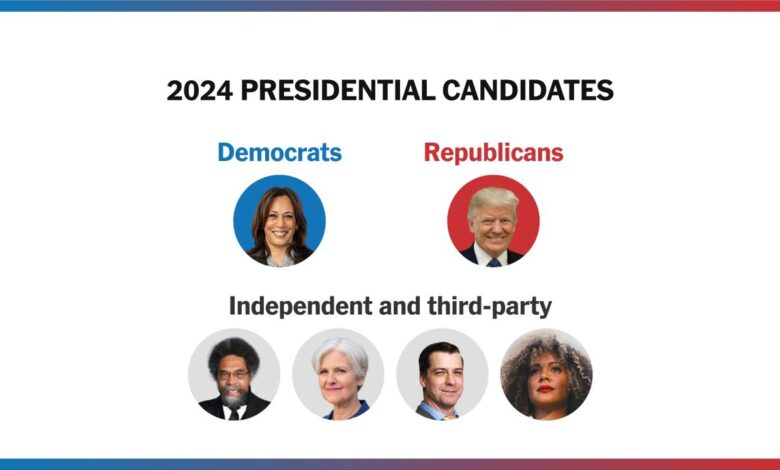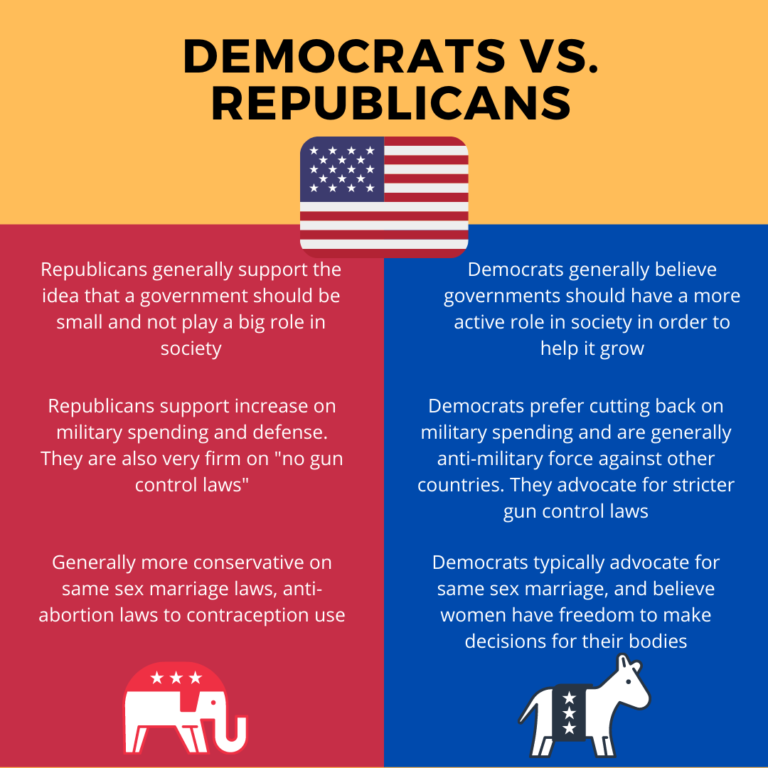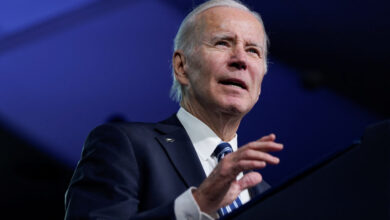
What Does the Republican Party Stand For Now?
What Does the Republican Party Stand For Now? That’s a question on many minds, and honestly, it’s a complex one. The Republican Party’s platform isn’t a monolithic entity; it’s a constantly evolving tapestry woven from diverse viewpoints and priorities. From economic policies and social issues to foreign affairs and environmental concerns, understanding the current Republican stance requires delving into the nuances of their positions on a wide range of critical topics.
This post aims to untangle some of that complexity, offering a clear look at where the party stands today.
We’ll explore their key policy positions across various sectors, comparing and contrasting them with other political viewpoints. We’ll examine their economic plans, their approach to social issues like abortion and LGBTQ+ rights, their foreign policy objectives, and their stance on environmental protection and healthcare. Get ready for a deep dive into the heart of modern Republicanism.
Economic Policies of the Republican Party: What Does The Republican Party Stand For Now
The Republican Party’s economic platform generally emphasizes principles of free markets, limited government intervention, and individual responsibility. This approach contrasts sharply with the Democratic Party’s platform, which typically advocates for a more active role for the government in regulating the economy and providing social safety nets. Understanding the nuances of the Republican platform is crucial for anyone interested in American politics and economics.
Republican Stance on Taxation
The Republican Party generally favors lower taxes across the board, arguing that this stimulates economic growth by encouraging investment and job creation. They often advocate for tax cuts for corporations and high-income earners, believing that this “trickle-down” effect benefits the entire economy. Specific proposals vary, but a common theme is simplifying the tax code and reducing tax rates to make the US more competitive globally.
Recent tax cuts enacted under Republican administrations have been justified on this basis, although their long-term economic effects remain a subject of ongoing debate. Critics argue that such tax cuts disproportionately benefit the wealthy and increase the national debt.
Republican Approaches to Government Spending
Republicans generally favor reduced government spending, advocating for fiscal responsibility and balanced budgets. They prioritize spending on national defense and tend to support measures aimed at controlling entitlement programs like Social Security and Medicare. This often involves proposals for reforming these programs to ensure their long-term solvency, which may include raising the retirement age or reducing benefits. The Republican approach to government spending is frequently characterized by a focus on efficiency and reducing the size of the federal government.
They often advocate for privatization of government services and deregulation to stimulate the private sector.
Comparison with the Democratic Party’s Economic Platform
The Republican and Democratic Parties hold fundamentally different views on the role of government in the economy. Democrats generally support higher taxes on corporations and wealthy individuals to fund social programs and reduce income inequality. They often advocate for government regulation to protect consumers and the environment, and they tend to favor government investment in infrastructure and education.
The contrast is particularly stark regarding social safety nets; Republicans generally favor a smaller role for government in providing such safety nets, while Democrats advocate for more robust government support for the poor and vulnerable. This difference in philosophy shapes their approaches to taxation, government spending, and economic regulation.
Summary of Key Elements of the Republican Economic Plan, What does the republican party stand for now
| Policy Area | Description | Intended Outcome | Potential Criticisms |
|---|---|---|---|
| Taxation | Lower taxes across the board, particularly for corporations and high-income earners. Tax code simplification. | Stimulate economic growth, encourage investment and job creation. | Increased national debt, disproportionate benefits to the wealthy, potential for regressive impact. |
| Government Spending | Reduced government spending, particularly on non-defense programs. Reform of entitlement programs. | Fiscal responsibility, balanced budgets, efficient government. | Potential cuts to essential services, negative impact on social safety nets, insufficient investment in infrastructure and education. |
| Regulation | Deregulation to stimulate private sector growth and competition. | Increased economic efficiency, job creation. | Potential for environmental damage, exploitation of workers, increased market instability. |
| Economic Growth | Focus on free markets and individual responsibility to drive economic growth. | Increased prosperity, job creation, higher standard of living. | Increased income inequality, potential for market failures, lack of social safety net. |
Social Issues and the Republican Platform
The Republican Party’s stance on social issues is a significant aspect of its platform, often shaping its political agenda and attracting a dedicated base of voters. These positions frequently spark intense public debate and influence national policy discussions. Understanding these positions is crucial for comprehending the party’s overall ideology and its impact on American society.
Abortion Rights
The Republican Party platform consistently advocates for the legal protection of unborn fetuses. This position translates into strong opposition to abortion rights, with many Republicans supporting measures that restrict access to abortion services. The party generally supports policies such as parental notification laws, waiting periods, and restrictions on abortion procedures. There’s a spectrum of views within the party, ranging from those who seek a complete ban on abortion to those who favor allowing exceptions in cases of rape, incest, or to save the mother’s life.
However, the overarching goal remains to limit abortion access.
LGBTQ+ Rights
The Republican Party’s position on LGBTQ+ rights is characterized by a significant degree of internal diversity and evolving viewpoints. While traditionally holding more conservative stances, recent years have seen some shifts within the party. However, the party’s official platform generally emphasizes traditional marriage definitions and often opposes same-sex marriage and other LGBTQ+ rights initiatives. Specific policies opposed often include anti-discrimination laws that explicitly protect LGBTQ+ individuals, particularly in areas such as employment and housing.
This position is not universally held within the Republican Party, with some members advocating for greater inclusivity and non-discrimination policies.
So, what does the Republican party stand for now? It’s a complex question, but a big part of understanding their current platform involves looking at how they’ve evolved. To truly grasp their current direction, it’s helpful to consider how a seemingly close race became such a decisive victory for Trump, as explored in this insightful article: how did a close run thing become a stonking trump win.
Understanding that shift illuminates the strategies and messaging that have defined the Republican party’s recent trajectory and what they stand for today.
Gun Control
The Republican Party generally advocates for the protection of Second Amendment rights, emphasizing the right of individuals to own and bear firearms. This translates into opposition to stricter gun control measures. The party typically resists proposals for expanded background checks, bans on assault weapons, and red flag laws. Instead, Republicans often focus on enforcing existing laws, promoting responsible gun ownership, and addressing mental health issues as ways to reduce gun violence.
The party’s position is rooted in the belief that restricting gun ownership infringes upon fundamental constitutional rights.
Key Social Policy Proposals
The following points summarize key social policy proposals often championed by the Republican Party:
- Protecting the sanctity of life from conception.
- Upholding traditional marriage and family values.
- Promoting religious freedom and the free exercise of religion.
- Supporting parental rights in education and child-rearing.
- Protecting the Second Amendment right to bear arms.
Foreign Policy and National Security
The Republican Party’s approach to foreign policy is generally characterized by a strong emphasis on national security, a willingness to use military force when deemed necessary, and a promotion of American interests on the global stage. This approach often prioritizes unilateral action when multilateral efforts are perceived as insufficiently effective or detrimental to American interests. However, the specific implementation of these principles has varied across different administrations and individual politicians within the party.
A key difference between Republican and Democratic approaches to national security lies in their preferred balance between military strength and diplomatic engagement. Republicans typically advocate for a robust military and a proactive foreign policy, often emphasizing military readiness and intervention as tools to protect American interests and promote global stability. Democrats, while also prioritizing national security, generally favor a more multilateral approach, emphasizing diplomacy, international cooperation, and a greater reliance on non-military solutions to address global challenges.
Republican Foreign Policy Positions on Key Global Issues
The Republican Party’s stances on key global issues reflect its overarching emphasis on national security and American interests. These positions often involve a more skeptical view of international institutions and agreements compared to the Democratic Party.
So, what does the Republican Party stand for these days? It’s a complex question, but a big part seems to be a focus on conservative values and a strong national defense. This is clearly on display in New Hampshire, where, as you can read in this article, retired general advances to battle new hampshire incumbent hassan for us senate seat , highlighting the party’s commitment to military experience in leadership.
The outcome of this race will be a significant indicator of the current direction and priorities of the Republican Party.
For example, on climate change, while there is internal debate within the party, the Republican platform has historically shown less commitment to international climate agreements and more emphasis on domestic energy independence. On international trade, Republicans generally favor free trade agreements but have also expressed concerns about trade imbalances and unfair competition, leading to protectionist measures at times. Regarding military intervention, the Republican Party has historically demonstrated a greater willingness to use military force abroad, often citing national security concerns or the need to protect American interests as justification.
Evolution of Republican Foreign Policy Over the Past Decade
The Republican Party’s foreign policy positions have evolved in subtle but significant ways over the past decade. This evolution is partly shaped by changing global dynamics, evolving internal party debates, and the experiences of different administrations.
| Year | Key Event/Policy Shift | Impact on Republican Foreign Policy |
|---|---|---|
| 2014 | Withdrawal of US troops from Iraq; Rise of ISIS | Renewed debate within the party regarding the optimal level of US military intervention and the effectiveness of nation-building efforts. |
| 2016 | Election of Donald Trump | Significant shift towards “America First” foreign policy, characterized by a more skeptical approach to international alliances and agreements, and a greater emphasis on bilateral relations. |
| 2018-2020 | Trade disputes with China; withdrawal from the Iran nuclear deal and the Paris Agreement | Increased focus on economic nationalism and unilateral action in foreign policy. |
| 2021-Present | Biden Administration’s foreign policy initiatives; evolving geopolitical landscape | Continued internal debate within the Republican party regarding the appropriate response to global challenges, with some advocating for a return to traditional alliances and others supporting a more isolationist approach. |
Environmental Policies

The Republican Party’s approach to environmental policy has evolved, but generally prioritizes economic growth alongside environmental protection, often emphasizing the role of free markets and technological innovation in achieving environmental goals. This contrasts with the Democratic Party’s often more stringent regulatory approach. Understanding the nuances of their positions requires examining their stances on specific issues.
Republican Party’s Current Environmental Policy Proposals
Current Republican environmental policy proposals generally focus on promoting energy independence, often through the continued use of fossil fuels, while also supporting advancements in technologies aimed at reducing emissions. There’s a strong emphasis on responsible resource management and conservation efforts, but the extent of these efforts varies considerably among individual Republicans and within different factions of the party. Proposals often emphasize state-level solutions and less federal intervention compared to their Democratic counterparts.
Specific proposals can vary depending on the individual politician and the specific context. For example, some Republicans support carbon capture technologies as a way to mitigate emissions from fossil fuel use, while others focus on promoting nuclear energy as a cleaner alternative.
So, what does the Republican Party stand for now? It’s a complex question, but lately, a lot of the focus seems to be on domestic issues. Thinking about that, it makes me wonder about our long-term vision – are we even looking beyond Earth? I recently read about how engineered dust could help make Mars habitable , which is pretty amazing.
Perhaps focusing on such ambitious projects could unite us, transcending partisan divides and reminding us of our shared human future, a future that requires a long-term vision, something I’m not sure the current Republican platform fully addresses.
Comparison of Republican and Democratic Approaches to Climate Change Mitigation
The Republican and Democratic parties diverge significantly in their approaches to climate change mitigation. Democrats generally accept the scientific consensus on anthropogenic climate change and advocate for aggressive action to reduce greenhouse gas emissions through policies like carbon pricing, increased investment in renewable energy, and stricter environmental regulations. Republicans, while some acknowledge the reality of climate change, often express skepticism about the extent of human impact and the need for drastic government intervention.
Their proposed solutions often focus on technological innovation, market-based mechanisms, and adaptation strategies rather than large-scale emissions reduction targets. This difference in perspective leads to vastly different policy proposals.
Republican Party’s Stance on Environmental Regulations
The Republican Party generally favors a less regulatory approach to environmental protection than the Democratic Party. Republicans often argue that excessive regulations stifle economic growth and job creation. They tend to advocate for deregulation or reform of existing environmental laws, arguing that they are overly burdensome and inefficient. They often promote a balance between environmental protection and economic development, seeking to find solutions that minimize negative impacts on businesses.
This stance often leads to disagreements with Democrats over the enforcement and implementation of environmental regulations.
Comparison of Republican and Democratic Positions on Environmental Issues
| Environmental Issue | Republican Position | Democratic Position |
|---|---|---|
| Renewable Energy | Support for technological advancements and market-driven growth, with varying levels of government support. | Strong support for government investment and incentives to rapidly expand renewable energy sources, aiming for a transition away from fossil fuels. |
| Fossil Fuels | Generally supports continued use of fossil fuels, often advocating for responsible resource management and technological advancements to reduce emissions. | Advocates for a transition away from fossil fuels, often supporting policies to phase out their use and promote renewable energy sources. |
| Conservation | Supports responsible conservation efforts, often emphasizing state and local management. | Supports robust federal and state conservation efforts, including land and water protection, and biodiversity initiatives. |
| Climate Change Mitigation | Focus on technological innovation, adaptation, and market-based solutions; skepticism towards aggressive government intervention and carbon pricing. | Strong support for aggressive mitigation strategies, including carbon pricing, emissions reduction targets, and international cooperation. |
Healthcare Policy
![]()
The Republican Party’s approach to healthcare in the United States centers on market-based reforms, emphasizing individual choice and competition among providers. This contrasts sharply with the Democratic Party’s focus on expanding government-funded healthcare access. While specific proposals vary among Republican politicians, common themes include deregulation, increased consumer choice, and cost-containment strategies.Republican Vision for Healthcare ReformThe Republican Party generally advocates for a shift away from the Affordable Care Act (ACA), often described as overly burdensome and inefficient.
Their vision involves repealing or significantly altering the ACA and replacing it with a system that emphasizes market forces. This often includes the promotion of health savings accounts (HSAs), tax credits to help individuals purchase private insurance, and increased competition among insurance providers. The goal is to create a more efficient and affordable healthcare system through increased consumer choice and market-driven innovation.
Addressing Healthcare Costs
Republican proposals to address rising healthcare costs typically focus on increasing market competition and transparency. They often support measures to reduce regulations on healthcare providers, believing this will increase supply and lower prices. Promoting price transparency, allowing patients to easily compare costs for various procedures and treatments, is another key element. Furthermore, Republicans often advocate for tort reform, aiming to limit frivolous medical malpractice lawsuits, which are believed to contribute to higher healthcare costs.
For example, proposals to cap non-economic damages in malpractice lawsuits are frequently discussed. The underlying principle is that a more competitive and transparent market will naturally drive down prices.
Comparison of Republican and Democratic Approaches to Healthcare Access
The fundamental difference between Republican and Democratic approaches to healthcare access lies in the role of government. Democrats generally favor a larger role for the government in ensuring healthcare access, often advocating for a single-payer system or a significant expansion of government-funded programs like Medicare. Republicans, conversely, prefer a more limited government role, emphasizing private insurance markets and individual responsibility.
This leads to differing views on issues such as universal healthcare coverage, the role of employer-sponsored insurance, and the extent of government subsidies for healthcare. The ACA, with its expansion of Medicaid and the creation of health insurance exchanges, exemplifies the Democratic approach, while Republican proposals generally aim to scale back such government interventions.
Potential Impacts of Republican Healthcare Policies on Different Segments of the Population
The potential impacts of Republican healthcare policies are complex and vary across different segments of the population. For example, healthier, wealthier individuals might benefit from lower premiums in a more competitive market, while those with pre-existing conditions or lower incomes could face challenges in accessing affordable coverage. The elderly, who rely heavily on Medicare, might see changes in the program’s structure and funding under Republican proposals.
Rural populations, often facing limited access to healthcare providers, could experience further difficulties if regulations are loosened and providers consolidate in urban areas. Ultimately, the impact will depend on the specifics of any proposed reforms and how they are implemented. Predicting precise effects requires sophisticated modeling and analysis, considering factors like the elasticity of demand for healthcare services and the response of providers to regulatory changes.
For example, a hypothetical scenario could involve a significant increase in the uninsured population among low-income individuals if subsidies are reduced or eliminated.
Education Policy
The Republican Party’s approach to education emphasizes local control, school choice, and parental involvement. Their platform aims to create a competitive education market that empowers parents and improves student outcomes through increased accountability and diverse educational options. While specific proposals vary depending on the individual candidate and state-level politics, several core tenets consistently appear within the party’s education policy.
School Choice and Charter Schools
Republicans generally support school choice initiatives, viewing them as a crucial tool to improve educational opportunities for disadvantaged students. This support extends to charter schools, which are publicly funded but independently operated. The argument is that competition among schools—both public and charter—will drive innovation and enhance the quality of education available to all children. Proponents suggest that school choice allows parents to select the best educational environment for their children, regardless of their geographic location or socioeconomic status.
Conversely, critics raise concerns about the potential for diverting public funds away from traditional public schools and the potential for charter schools to lack adequate oversight and accountability. Successful charter school models, such as those demonstrating high academic achievement in specific districts, are often cited as evidence of the potential benefits. Conversely, examples of failing charter schools that have not met their promises, leading to wasted resources, are used to illustrate the risks.
Funding Public Education
The Republican Party’s approach to funding public education generally favors increased efficiency and accountability within existing structures, rather than significant increases in overall spending. They often advocate for directing funding more directly to classrooms and teachers, rather than administrative overhead. This approach is often coupled with calls for greater transparency in how school districts allocate funds. While the party does not generally support massive increases in federal education spending, some Republicans advocate for targeted funding for specific programs or initiatives aimed at improving student achievement, particularly in areas of high need.
The specifics of funding mechanisms, such as block grants versus categorical grants, often vary depending on the context and specific legislative proposals. Examples of states that have successfully implemented cost-saving measures in public education while maintaining or improving student outcomes are frequently highlighted to support this approach. Conversely, concerns exist that reduced funding could negatively impact teacher salaries, class sizes, and access to essential resources in already under-resourced schools.
Potential Effects of Republican Education Policies on Student Outcomes
The potential effects of Republican education policies on student outcomes are complex and depend on several factors, including the specific policies implemented and the context in which they are implemented. Proponents argue that increased school choice and competition will lead to improved educational outcomes for all students, particularly those from disadvantaged backgrounds. They point to studies showing that students in some charter schools outperform their peers in traditional public schools.
Conversely, critics argue that school choice could exacerbate existing inequalities, leading to further segregation and disparities in educational opportunities. They highlight the potential for increased funding disparities between schools and the possibility of charter schools focusing on higher-achieving students, leaving behind those who need more support. The overall impact on student outcomes remains a subject of ongoing debate and research, with both positive and negative consequences observed depending on the specifics of the implementation and the context of the school system involved.
For example, a successful implementation of school choice in a district with robust oversight and a diverse range of high-quality charter schools could lead to improved student outcomes, while a poorly implemented program in a district with limited resources and weak accountability mechanisms could exacerbate inequalities.
So, what does the Republican Party stand for now? The answer, as we’ve seen, isn’t simple. It’s a multifaceted platform shaped by a dynamic interplay of economic, social, and geopolitical factors. While some core tenets remain consistent, the party’s positions on specific issues continue to evolve and adapt to the changing political landscape. Understanding these nuances is crucial for informed civic engagement and participation in the democratic process.
Hopefully, this exploration has shed some light on the complexities of the modern Republican platform, encouraging further research and critical thinking.





